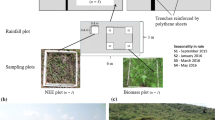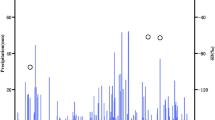Abstract
The global bamboo area has expanded by almost 50% in the past 30 years. These bamboo stands could impact rainfall partitioning and chemical characteristics. In this study, a field experiment was established to determine the rainfall physical partitioning and chemical characteristics in a bamboo stand in eastern China. The field experiment revealed that rainfall in the bamboo stand was partitioned into throughfall, stemflow, and interception loss, accounting for 80.2%, 9.0%, and 10.8% of the gross rainfall, respectively. The bamboo stand had significant effects on the pH and concentrations of Cl−, NO3−, SO42−, Ca2+, Mg2+, K+, Na+, and NH4+ in rainfall and water and element fluxes. The atmospheric rainfall pH value decreased as rainfall passed through the canopy of the bamboo stand. The elemental concentrations and element fluxes increased as rainfall passed through the canopy of the bamboo stand. Although canopy interception resulted in the lower annual water fluxes in the bamboo stand than in an open field, annual element fluxes in the bamboo stand were higher than those in the open field. The results of the study will facilitate a greater understanding of the atmospheric rainfall partitioning and hydrochemical fluxes in bamboo stands.





Similar content being viewed by others
References
André F, Jonard M, Ponette Q. 2008. Effects of biological and meteorological factors on stemflow chemistry within a temperate mixed oak-beech stand. Sci Total Environ 393:72–83. https://doi.org/10.1016/j.scitotenv.2007.12.002.
Cao YZ, Wang S, Zhang G, Luo J, Lu S. 2009. Chemical characteristics of wet precipitation at an urban site of Guangzhou, south China. Atmos Res 94:462–469. https://doi.org/10.1016/j.atmosres.2009.07.004.
Carlyle-Moses DE, Lishman CE, McKee AJ. 2014. A preliminary evaluation of throughfall sampling techniques in a mature coniferous forest. J for Res 25:407–413. https://doi.org/10.1007/s11676-014-0468-8.
Chen X, Zhang X, Zhang Y, Booth T, He X. 2009. Changes of carbon stocks in bamboo stands in china during 100 years. Forest Ecol Manag 258:489–1496. https://doi.org/10.1016/j.foreco.2009.06.051.
Chiwa M, Crossley A, Sheppard LJ, Sakugawa H, Cape JN. 2004. Throughfall chemistry and canopy interactions in a Sitka spruce plantation sprayed with six different simulated polluted mist treatments. Environ Pollut 127:57–64. https://doi.org/10.1016/S0269-7491(03)00259-8.
Chiwa M, Onozawa Y, Otsuki K. 2010. Hydrochemical characteristics of throughfall and stemflow in a Moso-bamboo (Phyllostachys pubescens) forest. Hydrol Process 24:2924–2933. https://doi.org/10.1002/hyp.7706.
Chuyong GB, Newbery DM, Songwe NC. 2004. Rainfall input, throughfall and stemflow of nutrients in a central African rain forest dominated by ectomycorrhizal trees. Biogeochemistry 67:73–91. https://doi.org/10.1023/B:BIOG.0000015316.90198.cf.
Corti G, Agnelli A, Cocco S, Cardelli V, Masse J, Courchesne F. 2019. Soil affects throughfall and stemflow under Turkey oak (Quercus cerris L.). Geoderma 333:43–56. https://doi.org/10.1016/j.geoderma.2018.07.010.
Dawoe EK, Barnes VR, Oppong SK. 2018. Spatio-temporal dynamics of gross rainfall partitioning and nutrient fluxes in shaded-cocoa (Theobroma cocoa) systems in a tropical semi-deciduous forest. Agrofor Syst 92:397–413. https://doi.org/10.1007/s10457-017-0108-3.
Dezzeo N, Chacón N. 2006. Nutrient fluxes in incident rainfall, throughfall, and stemflow in adjacent primary and secondary forests of the Gran Sabana, southern Venezuela. For Ecol Manag 234:218–226. https://doi.org/10.1016/j.foreco.2006.07.003.
Dong L, Han H, Kang F, Cheng X, Zhao J, Song X. 2020. Rainfall partitioning in Chinese pine (Pinus tabuliformis Carr.) stands at three different ages. Forests 11:243. https://doi.org/10.3390/f11020243.
Du EZ, Jiang Y, Fang JY, Vries WD. 2014. Inorganic nitrogen deposition in China’s forests: Status and characteristics. Atmos Environ 98:474–482. https://doi.org/10.1016/j.atmosenv.2014.09.005.
Eisalou HK, Şengönül K, Gökbulak F, Serengil Y, Uygur B. 2013. Effects of forest canopy cover and floor on chemical quality of water in broad leaved and coniferous forests of Istanbul, Turkey. Forest Ecol Manag 289:371–377. https://doi.org/10.1016/j.foreco.2012.10.031.
Fang Y, Gundersen P, Vogt RD, Koba K, Chen F, Chen XY, Yoh M. 2011. Atmospheric deposition and leaching of nitrogen in Chinese forest ecosystems. J for Res 16:341–350. https://doi.org/10.1007/s10310-011-0267-4.
FAO. 2020. Global Forest Resources Assessment 2020: Main report. Food and Agriculture Organization of the United Nations, Rome. https://doi.org/10.4060/ca9825en.
Grunicke S, Queck R, Bernhofer C. 2020. Long-term investigation of forest canopy rainfall interception for a spruce stand. Agr Forest Meteorol 292–293. https://doi.org/10.1016/j.agrformet.2020.108125.
Hegde A, Sitharam TG. 2015. Use of bamboo in soft-ground engineering and its performance comparison with geosynthetics: experimental studies. J Mater Civil Eng 27. https://doi.org/10.1061/(ASCE)MT.1943-5533.000122
Horowitz AJ. 2008. Determining annual suspended sediment and sediment-associated trace element and nutrient fluxes. Sci Total Environ 400:315–343. https://doi.org/10.1016/j.scitotenv.2008.04.022.
Hu Y, Zhao P, Shen W, Zhu L, Ni G, Zhao X, Zhang Z, Rao X, Ouyang L, Zeng X, Sun D, Lin Y. 2018. Responses of tree transpiration and growth to seasonal rainfall redistribution in a subtropical evergreen broad-leaved forest. Ecosystems 21:811–826. https://doi.org/10.1007/s10021-017-0185-1.
Huber A, Iroumé A. 2001. Variability of annual rainfall partitioning for different sites and forest covers in Chile. J Hydrol 248:8–92. https://doi.org/10.1016/S0022-1694(01)00394-8.
Jung K, Chang SX. 2012. Four years of simulated N and S depositions did not cause N saturation in a mixedwood boreal forest ecosystem in the oil sands region in northern Alberta, Canada. Forest Ecol Manag 280:62–70. https://doi.org/10.1016/j.foreco.2012.06.002.
Kowalska A, Astel A, Boczoń A, Polkowska Ż. 2016. Atmospheric deposition in coniferous and deciduous tree stands in Poland. Atmos Environ 133:145–155. https://doi.org/10.1016/j.atmosenv.2016.03.033.
Kristensen H, Gundersen P, Callesen I, Reinds GJ. 2004. Throughfall nitrogen deposition has different impacts on soil solution nitrate concentration in European coniferous and deciduous forests. Ecosystems 7:180–192. https://doi.org/10.1007/s10021-003-0216-y.
Larssen T, Duan L, Muder J. 2011. Deposition and leaching of Sulfur, Nitrogen and Calcium in four forested catchments in China: implications for acidification. Environ Sci Technol 45:1192–1198. https://doi.org/10.1021/es103426p.
Levia DF, Frost EE. 2003. A review and evaluation of stemflow literature in the hydrologic and biogeochemical cycles of forested and agricultural ecosystems. J Hydrol 274:1–29. https://doi.org/10.1016/S0022-1694(02)00399-2.
Li K, Wan J, Wang X, Wang J, Zhang J. 2016. Comparison of dilute acid and alkali pretreatments in production of fermentable sugars from bamboo: effect of tween 80. Ind Crop Prod 82:414–422. https://doi.org/10.1016/j.indcrop.2016.01.003.
Liu X, Zhang Y, Han W, Tang A, Shen J, Cui Z, Vitousek P, Erisman JW, Goulding K, Christie P, Fangmeier A, Zhang F. 2013. Enhanced nitrogen deposition over China. Nature 494:459–462. https://doi.org/10.1038/nature11917.
Liu Z, Wang Y, Tian A, Liu Y, Webb A, Wang Y, Zuo H, Yu P, Xiong W, Xu L. 2018. Characteristics of canopy interception and its simulation with a revised Gash model for a larch plantation in the Liupan Mountains, China. J for Res 29:187–198. https://doi.org/10.1007/s11676-017-0407-6.
Llorens P, Domingo F. 2007. Rainfall partitioning by vegetation under Mediterranean conditions. A review of studies in Europe. J Hydrol 335:37–54. https://doi.org/10.1016/j.jhydrol.2006.10.032.
Lovett GM. 1994. Atmospheric deposition of nutrients and pollutants in North America: an ecological perspective. Ecol Appl 4:629–650. https://doi.org/10.2307/1941997.
Ma TY, Liu XY, Xu SQ, Guo HR, Song W. 2020. Levels and variations of soil organic carbon and total nitrogen among forests in a hotspot region of high nitrogen deposition. Sci Total Environ 713:136620. https://doi.org/10.1016/j.scitotenv.2020.136620.
Ni H, Su W, Fan S, Chu H. 2021. Effects of intensive management practices on rhizosphere soil properties, root growth, and nutrient uptake in Moso bamboo plantations in subtropical China. Forest Ecol Manag 493:119083. https://doi.org/10.1016/j.foreco.2021.119083.
Ohuchi T, Nakahara M, Murase Y. 2006. Cross-sectional cutting of bamboo with a pair of shearing blades for bamboo cube production. J Wood Sci 52:274–278. https://doi.org/10.1007/s10086-005-0749-0.
Parker GG. 1983. Throughfall and stemflow in the forest nutrient Cycle. Adv Ecol Res 13:57–133. https://doi.org/10.1016/S0065-2504(08)60108-7.
Peng H, Zhao C, Feng Z, Xu Z, Wang C, Zhao Y. 2014. Canopy interception by a spruce forest in the upper reach of Heihe River basin, Northwestern China. Hydrol Process 28:1734–1741. https://doi.org/10.1002/hyp.9713.
Phoenix GK, Emmett BA, Britton AJ, Caporn SJM, Dise NB, Helliwell R, Jones L, Leake JR, Leith ID, Sheppard LJ. 2011. Impacts of atmospheric nitrogen deposition: Responses of multiple plant and soil parameters across contrasting ecosystems in long-term field experiments. Glob Chang Biol 18:1197–1215. https://doi.org/10.1111/j.1365-2486.2011.02590.x.
Qian Z, Zhuang S, Gao J, Tang L. 2022. Can aeration improve bamboo soil fertility of soil below bamboo and fungal diversity under mulching conditions? Land Degrad Dev 33:2353–2365. https://doi.org/10.1002/ldr.4311.
Sheng H, Guo N, Ju C, Cai T. 2021. Variation of nutrient fluxes by rainfall redistribution processes in the forest canopy of an urban larch plantation in northeast China. J for Res. https://doi.org/10.1007/s11676-021-01407-8.
Song X, Zhou G, Jiang H, Yu S, Fu J, Li W, Wang W, Ma Z, Peng C. 2011. Carbon sequestration by Chinese bamboo forests and their ecological benefits: assessment of potential, problems, and future challenges. Environ Rev 19:418–428. https://doi.org/10.1139/a11-015.
Su L, Zhao C, Xu W, Xie Z. 2019. Hydrochemical fluxes in bulk precipitation, throughfall, and stemflow in a mixed evergreen and deciduous broadleaved forest. Forests 10:507. https://doi.org/10.3390/f10060507.
Swaffer BA, Holland KL, Doody TM, Hutson J. 2014. Rainfall partitioning, tree form and measurement scale: A comparison of two co-occurring, morphologically distinct tree species in a semi-arid environment. Ecohydrology 7:1331–1344. https://doi.org/10.1002/eco.1461.
Tian Y, Haibara K, Chang SX, Toda H, Fang S. 2013. Acid deposition strongly influenced element fluxes in a forested karst watershed in the upper Yangtze River region, China. Forest Ecol Manag 310:27–36. https://doi.org/10.1016/j.foreco.2013.08.008.
Vogtländer J, Lugt RVD, Brezet R. 2010. The sustainability of bamboo products for local and Western European applications. Lcas and Land-Use. J Clean Prod 18:1260–1269. https://doi.org/10.1016/j.jclepro.2010.04.015.
Weathers KC, Lovett GM, Likens GE, Caraco NFM. 2000. Cloudwater inputs of nitrogen to forest ecosystems in southern Chile: forms, fluxes, and sources. Ecosystems 3:590–595. https://doi.org/10.1007/s100210000051.
Xiao Q, Mcpherson EG. 2011. Rainfall interception of three trees in Oakland, California. Urban Ecosyst 14:755–769. https://doi.org/10.1007/s11252-011-0192-5.
Zhang YF, Wang XP, Hu R, Pan YX, Paradeloc M. 2015. Rainfall partitioning into throughfall, stemflow and interception loss by two xerophytic shrubs within a rain-fed re-vegetated desert ecosystem, northwestern China. J Hydrol 527:1084–1095. https://doi.org/10.1016/j.jhydrol.2015.05.060.
Zhang S, Yu J, Pan T, Gao X, Hou L. 2021. Difference between rainfall and throughfall chemistry for different forest stands in the Qinling Mountains, China. Hydrol Res 52:523–535. https://doi.org/10.2166/nh.2021.015.
Zhou BZ, Fu MY, Xie JZ, Yang XS, Li ZC. 2005. Ecological functions of bamboo forest: research and application. J for Res 16:143–147. https://doi.org/10.1007/BF02857909.
Zhu J, Yu L, Xu T, Wei X, Yang K. 2019. Comparison of water quality in two catchments with different forest types in the headwater region of the Hun River, Northeast China. J for Res 30:565–576. https://doi.org/10.1007/s11676-018-0688-4.
Acknowledgements
This work was funded by the National Key Research and Development Program of China (grant number 2021YFD2201202), Biodiversity Protection Project of Ministry of Ecology and Environment, China (grant number 2110404), and Priority Academic Program Development of Jiangsu Higher Education Institutions (PAPD).
Author information
Authors and Affiliations
Contributions
LT designed the experiment. LT, YL, BW, and XG collected the data. TY and YO conducted the statistical analyses. TY, YO, and LT wrote the first draft of the manuscript, and all coauthors edited the manuscript.
Corresponding author
Ethics declarations
Conflict of interest
The authors declare that they have no known competing financial interests or personal relationships that could have appeared to influence the work reported in this paper.
Supplementary Information
Below is the link to the electronic supplementary material.
Rights and permissions
Springer Nature or its licensor (e.g. a society or other partner) holds exclusive rights to this article under a publishing agreement with the author(s) or other rightsholder(s); author self-archiving of the accepted manuscript version of this article is solely governed by the terms of such publishing agreement and applicable law.
About this article
Cite this article
Yang, T., Li, Y., Ouyang, X. et al. Bamboo Plantation Establishment Changes Rainfall Partitioning and Chemistry. Ecosystems 26, 1326–1334 (2023). https://doi.org/10.1007/s10021-023-00834-4
Received:
Accepted:
Published:
Issue Date:
DOI: https://doi.org/10.1007/s10021-023-00834-4




